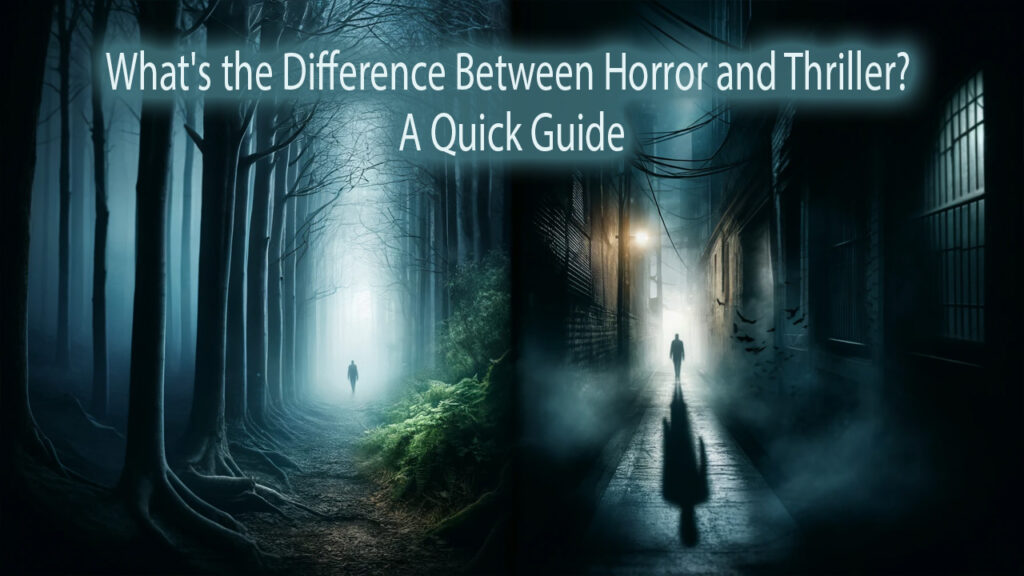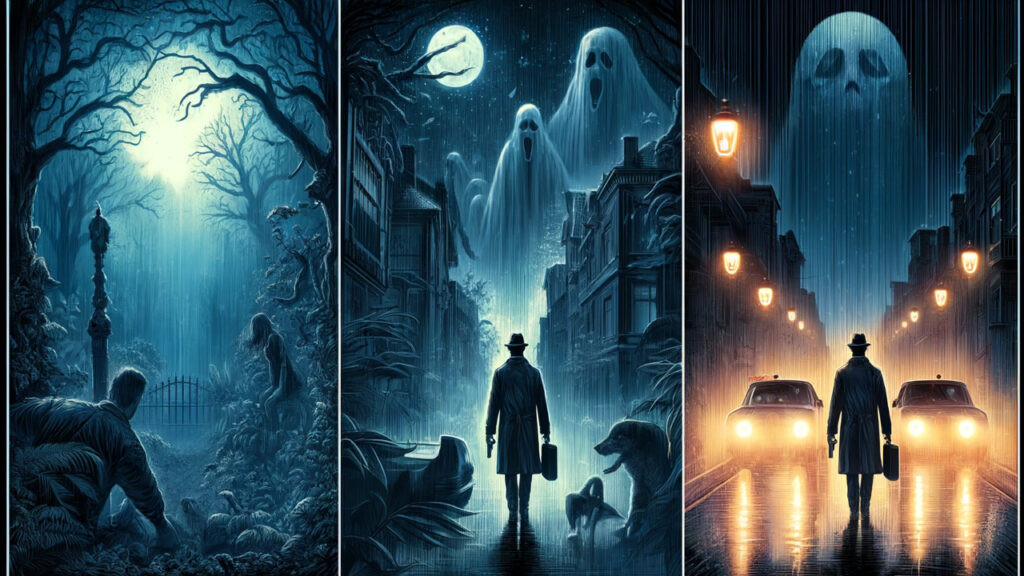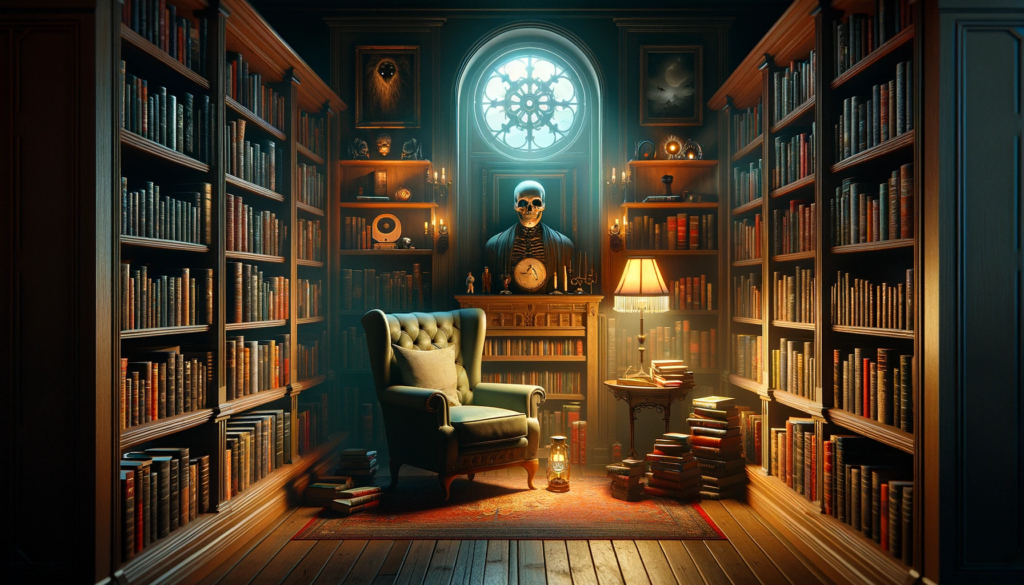
Have you ever found yourself in a heated debate over the difference between horror and thriller? Perhaps it’s during a movie night that takes a turn from casual to contentious, or maybe it’s a spirited discussion with friends about which genre does a better job at keeping audiences on the edge of their seats. These conversations often reveal just how passionate we can be about the movies and books we love.
As an author of both horror and thriller books and stories, I can help you distinguish between horror vs thriller with a few quick tips.
This guide on the difference between horror and thriller aims to clarify what exactly sets horror apart from thriller, providing you with insights to not only win your next genre debate but also enhance your appreciation of these distinct but occasionally overlapping categories.
Core Difference Between Horror and Thriller Explained
Understanding the nuances in the difference between horror and thriller is essential for any aficionado of suspenseful and fear-inducing media. Both genres aim to engage their audience deeply, but they do so through different mechanisms and with distinct goals in mind. Let’s explore the critical differences that set horror and thriller apart, using a clear breakdown of their foundational elements.
Emotional Focus
The emotional focus within the difference between horror and thriller indicates how a person will usually react and how they are affected.
Horror: This genre is dedicated to evoking intense fear and dread. Horror films and books exploit supernatural elements, monstrous entities, and dark, foreboding atmospheres to trigger the audience’s primal fears. In the comparison of horror vs thriller, horror aims to disturb and unsettle, ensuring that the fear lingers long after the story ends.
Thriller: Thrillers are crafted to captivate with high stakes and relentless suspense. They often integrate elements from the horror genre to enhance the tension, showing how thriller and horror can sometimes blur together. However, thrillers primarily focus on keeping the audience guessing and engaged through complex plots and constant threats.
Perspective and Character Focus
The perspective in horror and thriller films significantly influences how stories are perceived.
Horror typically presents the narrative through the eyes of the victim, immersing the audience in a constant sense of danger and vulnerability.
Thrillers, however, might switch perspectives between the protagonist and antagonist, creating a layered narrative that offers insight into each character’s motives and plans. This dynamic can dramatically alter the viewer’s experience, showcasing the versatility and depth that thrillers can offer.
Predictability vs. Unpredictability
One of the defining features in the difference between horror and thriller is how each genre manages audience expectations.
Horror tends to follow a more predictable path, focusing on established conventions to deliver its scares effectively. Audiences often know what to expect but are still terrified by the execution.
Conversely, thrillers thrive on unpredictability, crafting narratives that twist and turn in unexpected ways, keeping viewers on the edge of their seats as they try to piece together the puzzle before the climax.
Nature of Antagonism
Exploring the antagonists in both genres reveals a further difference between horror and thriller.
In horror, the antagonist is often something (or someone) not entirely human, an entity that embodies pure evil or otherworldliness. This stark portrayal enhances the genre’s intent to evoke fear through an unknown or incomprehensible threat.
On the other hand, thrillers frequently portray their villains as complex characters, sometimes even making them the protagonists. This blend of “thriller and horror” elements can lead to a deeper psychological connection with the antagonist, adding layers of moral ambiguity and intrigue that are less common in pure horror.

Case Studies: Illustrating the Difference Between Horror and Thriller
To further understand the difference between horror and thriller, let’s examine some classic and modern examples from both genres. These case studies not only highlight the inherent differences but also demonstrate how each genre manipulates audience emotions and expectations.
Horror Case Studies
- “The Exorcist” (1973): One of the most iconic horror films, “The Exorcist” taps into primal fears through its depiction of demonic possession. The movie’s ability to instill deep dread and terror comes from its unflinching portrayal of the supernatural affecting the innocent, embodying the horror genre’s focus on fear above all else.
- “Hereditary” (2018): This modern horror masterpiece uses family trauma and an unsettling atmosphere to create a deeply horrifying experience. The film’s relentless build-up of dread and its shocking climactic twists exemplify how horror can manipulate audience emotions through unexpected narrative developments, keeping viewers intensely engaged and frightened.
- “It” (2017): Based on Stephen King’s novel, “It” combines childhood fears with the threat of an otherworldly monster. The film’s focus on the group of children (the Losers’ Club) and their perspectives enhances the horror elements, making their encounters with Pennywise not just terrifying but also a deep dive into the fears we carry from childhood.
Thriller Case Studies
- “Gone Girl” (2014): This thriller unravels the complexities of a troubled marriage and the extreme lengths to which the characters go to manipulate each other and the public. The shifting perspectives and the unpredictable narrative keep the audience guessing, showcasing the thriller genre’s emphasis on suspense and psychological tension.
- “Inception” (2010): A heist thriller set within the architecture of the human mind, “Inception” explores the concept of planting an idea through a dream within a dream. The film’s complex plot and the ethical dilemmas faced by the characters highlight the thriller’s focus on high stakes and moral quandaries, pushing the boundaries of traditional thrill-seeking narratives.
- “Zodiac” (2007): Based on the true story of the hunt for the Zodiac killer, this film blends historical facts with a gripping narrative. “Zodiac” is a prime example of a thriller that combines mystery with a procedural investigation, keeping viewers engrossed and on edge as the characters pursue the elusive killer across time.
While these stories show a clear difference between horror and thriller, there are times when movies blur the lines between genres. Let me explain.

Crossing Paths: When Horror Meets Thriller
While the difference between horror and thriller is usually clear, there are exceptional cases where films and books blur the lines between these two genres, merging elements of both to create uniquely suspenseful and terrifying narratives. These hybrids challenge the conventional boundaries and provide rich, complex experiences that captivate and scare audiences simultaneously.
“The Silence of the Lambs” (1991): Often categorized as a psychological thriller, this film also incorporates significant horror elements. The intense focus on the mind of a serial killer and the graphic nature of his crimes inject a level of horror that complements the thriller’s suspenseful investigation. This blend makes “The Silence of the Lambs” a quintessential example of how the lines between horror and thriller can be effectively blurred.
“Se7en” (1995): This dark thriller revolves around the hunt for a serial killer who uses the seven deadly sins as his motif. The gruesome nature of the killings and the pervasive sense of dread throughout the film blur the line with horror, as it explores themes of evil and despair that are typically found in horror narratives.
“Get Out” (2017): Jordan Peele’s debut film is primarily a thriller with strong social commentary, but its use of unsettling horror tropes to amplify the psychological and physical threats faced by the protagonist blurs genres. The film’s incorporation of body horror and elements of psychological terror alongside a suspenseful plot aligns it uniquely at the intersection of horror and thriller.
These examples illustrate that the difference between horror and thriller is not always distinct. By blending elements of thriller and horror, filmmakers and writers create a gripping, multidimensional experience that can appeal to fans of both genres.
Understanding these overlaps can enhance our appreciation for how narrative elements are manipulated to provoke a range of emotional responses, from fear to edge-of-the-seat excitement.

Conclusion: Understanding the Difference Between Horror and Thriller Genres
In exploring the difference between horror and thriller, it’s clear that each genre has its unique appeal and method of engaging the audience. Horror seeks to elicit fear and dread through supernatural or grotesque elements, focusing on the victim’s perspective to enhance the feeling of terror. Thrillers, on the other hand, engage through suspense and unpredictability, often providing multiple perspectives that include the antagonist’s, which adds depth and complexity to the narrative.
While the difference between horror and thriller is clear, these genres can sometimes overlap, creating stories that harness the strengths of both to captivate and frighten audiences in equal measure. Whether you lean towards the eerie depths of horror or the tense edges of thriller, both genres offer rich, immersive experiences that reflect the broad spectrum of human emotions and fears.

For those intrigued by both horror and thriller, we invite you to explore the Celenic Earth Publications’ “CEA Greatest Anthology Written,” an anthology of 109 short stories that spans various genres, including horror and thriller. This collection is a testament to the diverse storytelling that can be achieved when these two genres blend together.
Additionally, for fans of survival horror, don’t miss “Sacred Valley: Betrayal,” available in our online bookshop. Inspired by the chilling atmosphere of the Silent Hill games, this book promises to deliver a thrilling and eerie experience, perfect for those who appreciate the horror genre’s ability to push the boundaries of fear.
Discover these captivating reads and more at Celenic Earth Publications, where the line between horror and thriller is both respected and artfully blurred. Thank you for reading my detailed article on the difference between horror and thriller!


